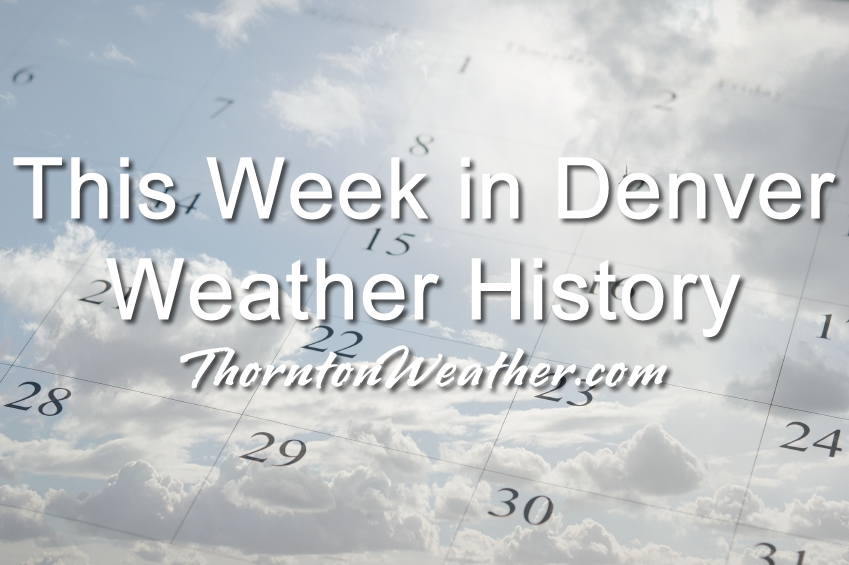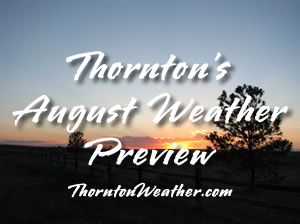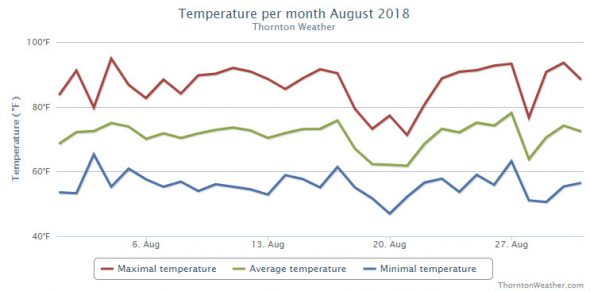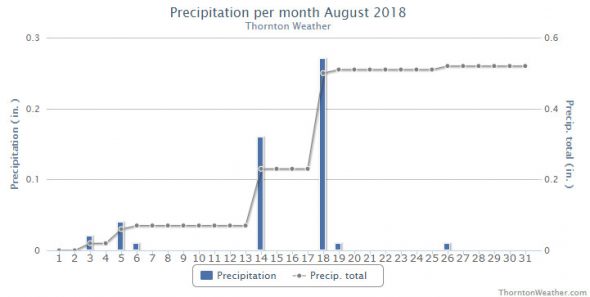
Colorado’s unofficial severe weather season may be over but August holds a wide variety of related weather hazards that can be damaging and deadly. Looking back at this week in Denver weather history, flooding, large hail and even tornadoes have made appearances in our past.
From the National Weather Service:
8-13
In 1875…clouds of grasshoppers were seen flying through the air on the prevailing winds during each day.
11
In 1872…fog was very dense until about 8:00 am. There was water dripping from the roofs of houses as if it had rained. The rain gage showed 0.01 inch of moisture…even though there had been no rainfall.
In 1927…an apparent dry microburst produced only a trace of rain and brief northwest winds sustained to 34 mph with gusts to 44 mph.
In 1980…hail up to golf ball size caused some roof and car damage in the southern part of Aurora.
In 1990…lightning ignited a storage tank filled with 10 thousand gallons of crude oil in a farmer’s field near Dacono…25 miles north of Denver. Flames shot to 40 feet high for nearly 2 hours before being extinguished. A lightning bolt also struck 21 miles north of Denver at an Erie fire station…causing extensive damage to the gas meter and electrical system. The sudden power surge blew out the station’s television set…a refrigerator…and a pop machine. Small fires spread throughout the structure… Totally destroying the building’s electrical wiring. The fires were quickly extinguished by the in-resident fire fighters. Golf ball size hail was reported in Denver near the intersection of Santa Fe Drive and I-25.
In 2012…a severe thunderstorm produced a wind gust to 60 mph at rocky mountain metropolitan airport.
In 1992…dime size hail fell in Westminster.
In 1994…strong thunderstorms produced large hail across northwest and north metro Denver. One inch diameter hail fell in Brighton with 3/4 inch hail reported in Westminster and at Indian Hills in the foothills west of Denver. Lightning struck a house in Arvada. The resulting fire destroyed one-third of the house. Funnel clouds were sighted over Westminster.
In 1997…large hail…strong winds…and torrential rains hammered portions of Lakewood and south Denver. Nearly 1 inch of rain fell in the span of 10 minutes in south Denver with a storm total of 1.81 inches. Street flooding was extensive as gutters and other drainage systems in the area were clogged by hail…piled several inches deep…and other debris. Strong thunderstorm winds to 50 mph and large hail accompanied by heavy rain caused extensive damage to cars…homes…and businesses. Several trees were downed by the strong winds…and trees were stripped of their leaves by hail. A water lily exhibition on display at the Denver botanic gardens was heavily damaged. Final estimates of the damage included 60 million dollars to automobiles and an additional 68 million dollars to homes and businesses. Hail to 1 1/2 inches in diameter fell in south Denver with 3/4 to 1 inch hail in Lakewood. A man received minor injuries in Aurora when he was struck by lightning while talking on the telephone.
In 2003…hail to 3/4 inch in diameter was measured in Aurora near Cherry Creek.
12
In 1876…the temperature climbed to a high of 100 degrees in downtown Denver.
In 1941…excessive thunderstorm rainfall flooded streets and delayed traffic for a few hours in some sections of the city. The basements of a considerable number of homes and commercial buildings were flooded. The total value of the damage was unknown. Only 0.94 inch of thunderstorm rainfall was recorded downtown.
In 1969…a man and a 9-year old boy were injured…when lightning struck a tree near where they were standing. Both were revived after treatment…but the boy later died of respiratory failure due to electrical shock.
In 1984…heavy thunderstorm rains drenched southern metro Denver. Rural roads in Douglas County received minor washouts. Hail…as large as 3/4 inch in diameter…was reported in southeast Aurora with one inch diameter hail reported near Parker. Rainfall totaled 1.00 inch at Stapleton International Airport.
12-13 in 1975…heavy rains caused flash flooding along the foothills from Denver north. Thunderstorm rainfall totaled 1.56 inches at Stapleton International Airport.
In 2004…a brief cool spell resulted in two daily temperature records. The low temperature of 49 degrees was a record minimum for the 12th…as was the low temperature of 48 degrees on the 13th.
13
In 1959…thunderstorm winds gusted to 53 mph at Stapleton Airport.
In 1983…thunderstorms dumped torrential rain in Northglenn… Thornton…and Broomfield. Northglenn was drenched with 1.72 inches in 30 minutes. Street flooding was widespread. Hail…as large as 3/4 inch in diameter…was reported 7 miles northeast of Boulder along with heavy rain which caused some street flooding.
In 2000…lightning sparked 3 small grass fires near Golden. The fires were quickly contained. Hail as large as 3/4 inch in diameter fell in Castle Rock.
14
In 1960…a bolt of lightning struck a man in Henderson… Causing serious burns.
In 1962…the temperature climbed to a high of 100 degrees at Stapleton Airport.
In 1968…a young man on a golf course in Denver was injured when lightning struck a tree under which he was standing. Lightning caused minor damage to a house in Denver. Heavy thunderstorm rain caused local street flooding. One inch diameter hail fell at Jefferson County Airport near Broomfield.
In 1973…winds as high as 85 mph damaged 20 aircraft at the Arapahoe County airport…now Centennial Airport.
In 1977…three tornadoes were sighted in Bennett. A man suffered a broken leg when hit by a flying board. He was outside his camper home…which was destroyed. All windows were broken in a near-by farmhouse where some shingles were ripped off and a 2 car garage was knocked down. Several vehicles were damaged and a cat…some rabbits…and chickens were killed. A broken oar from a boat was driven into the side of a house. A mobile home was overturned. One old barn was destroyed. Half a dozen homes and several agricultural buildings were damaged just west of State Highway 79.
In 1978…high winds produced much blowing dust…causing many traffic accidents in the Denver-Boulder area. Winds gusts of 70 to 101 mph were recorded. Northwest winds gusted to 44 mph at Stapleton International Airport.
In 1980…lightning hit two power poles in Littleton…causing 400 dollars in damage. Rainfall of 1.23 inches in a short time caused minor flooding…which included damage to a ground floor apartment and partially submerging a few vehicles in water. Thunderstorm rainfall totaled 0.98 inch at Stapleton International Airport.
In 1983…2.10 inches of rain drenched Golden in an hour with similar amounts in Lakewood and Boulder. Over ten thousand dollars’ worth of plants were washed away at a nursery in Lakewood.
In 1997…twelve motorists were injured in a multi-car accident when strong microburst winds estimated to 50 mph blew blinding dust across I-70 near Bennett.
In 1998…lightning struck a hydro-electric plant in Nederland… Causing a power outage. Residents in the foothills west of Boulder…including Nederland…Ward…Eldora…Jamestown… and Gold Hill…were without power for about an hour.
In 2006…heavy thunderstorm rainfall near Deckers washed away some the banks along State Highway 67 between Deckers and Westcreek. Several driveways on both sides of the highway were also damaged.
Continue reading August 11 to August 17: This Week in Denver Weather History



